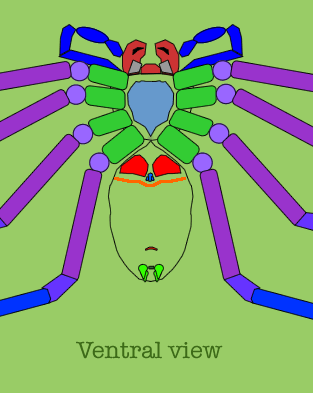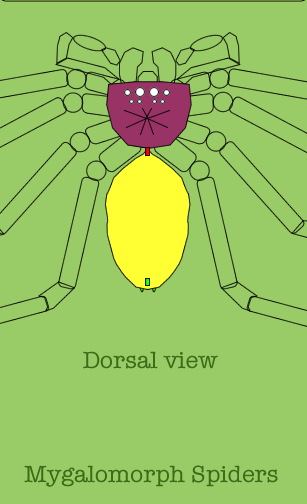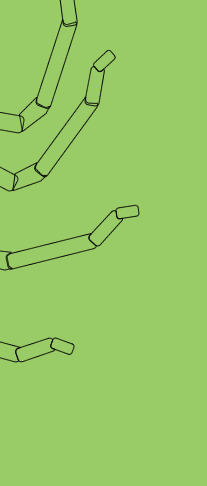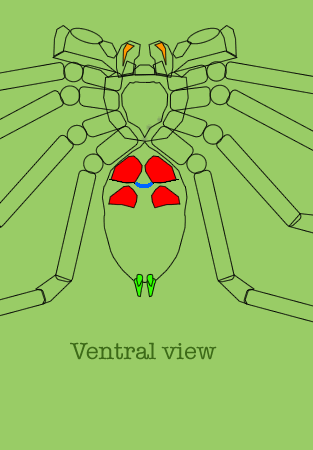
|
|||||||||||||||||||||||||||||||||
Spider glossary |
|
Abdomen |
The posterior division of the spider body, comprising the pedicel and usually largely unsegmented saclike portion bearing the spinnerets. |
|
Accessory claws |
Serrated, thickened hairs near the true claws in some spiders. |
|
Anal tubercle |
A small projection,the caudal tubercle, dorsal to the spinnerets, carrying the anal opening. |
|
Annulations |
Rings of pigmentation around leg segments. |
|
Antennae |
The segmented sensory organs often termed "feelers," borne on the heads of insects, crustacea, et cetera, but missing in all arachnids. The palps of spiders resemble and may be mistaken for antennae. |
|
Anterior |
Nearer the front or head end. |
|
Appendages |
Parts or organs (such as legs, spinnerets, chelicerae) that are attached to the body. |
|
Arachnida |
A principal division, or Class, of the air-breathing arthropods, the arachnids, including the scorpions, mites, spiders, harvestmen, etc. |
|
Arachnologist |
One who studies the arachnids. |
|
Araneae |
The ordinal name of all spiders; same as Araneida. |
|
Araneology |
The branch of zoology that treats only of the spiders. |
|
Arthropod |
The jointed-legged animals, such as centipedes, millipedes, insects, crustaceans, spiders, scorpions, and many other less well-known types; the members of the Phylum Arthropoda. |
|
Attachment disc |
The series of tiny lines that serve to anchor the draglines of spiders. |
|
Autophagy |
The eating of an appendage shed from the body by autotomy or otherwise. |
|
Autospasy |
The loss of appendages by breaking them at a predetermined locus of weakness when pulled by an outside form; frequent in spiders and arachnids. |
|
Autotomy |
The act of reflex self-mutilation by dropping appendages; unknown in the arachnids. |
|
Ballooning |
Flying through the air on silken lines spun by spiders. Aeronautical dispersal by means of air currents acting on strands of silk. |
|
Book lungs |
The respiratory pouches opening on the underside of the abdomen of the arachnids, filled with closely packed, blood filled leaves or folds to provide maximum surface for aeration; believed to be modified, insunk gills. |
|
Branchial operculum |
A sclerotized, hairless plate overlying the book lung. |
|
Calamistrum |
The more-or-less extensive row of curved hairs on the hind metatarsi (metatarsus IV), used to comb the silk from the cribellum. |
|
Carapace |
The exoskeletal covering, or shell, over the dorsal (upper) surface of the cephalothorax. |
|
Cardiac mark |
An elongate midline mark on the anterior, dorsal surface of the abdomen which overlies the heart. |
|
Catalepsy |
The action of feigning death; induced by disturbance. |
|
Cephalothorax |
The united head and thorax of Arachnida and Crustacea. The anterior (front) of the two major divisions of the body of a spider. |
|
Chelicerae |
The pincerlike first pair of appendages of the arachnids; in spiders two-segmented, the distal portion or fang used to inject venom from enclosed glands into the prey. The jaws, each one comprising a large basal part and a fang |
|
Chitin |
A linear homopolysaccharide found as the characteristic molecule in the cuticle of arthropods. The molecules are layered in chains and cross-linked to form the strong, lightweight basis of the cuticle. |
|
Chorion |
The outer covering or shell of the spider or insect egg. |
|
Claw tufts |
The pair of tufts of adhesive hairs present below the paired claws at the tip of the tarsi of many spiders. |
|
Clypeus |
The area between the anterior row of eyes and the anterior edge of the carapace. |
|
Colulus |
The slender or pointed midline appendage or tubercle immediately in front of the spinnerets of some spiders; in others greatly reduced or seemingly missing; the homologue of the anterior median spinnerets or cribellum. |
|
Conductor |
A semi-membranous structure in the male palp which supports and guides the embolus in insemination. |
|
Condyle |
A smooth, rounded protuberance sometimes present on the outer side of the chelicera, near its base. |
|
Coxa |
The segment of leg nearest the body by means of which it is articulated to the body; modified in the palp to form the maxilla. |
|
Coxal glands |
The excretory organs of arachnids, in spiders located opposite the coxae of the first and third legs, that collect wastes into a saccule and discharge them through tubes opening behind the coxae; homologous with the nephridia of Peripatus, etc. |
|
Cribellum |
A sievelike, transverse plate, usually divided by a delicate keel into two equal parts, located in front of the spinnerets of many spiders; the modified anterior median spinnerets. Only present in cribellate spiders, which also have a calamistrum. |
|
Cuticle |
The hard outer covering of an arthropod. |
|
Cymbium |
The broadened, hollowed-out tarsus of the male palp within which the palpal organs are attached. |
|
Deutovum |
The resting, spiderlike stage following the shedding of the chorion of the egg; the second egg. |
|
Distal |
Pertaining to the outer end, furthest away from the body or point of attachment. |
|
Dorsal |
Pertaining to the upper surface. |
|
Dorsum |
In general, the upper surface. |
|
Ecdysis |
The process of casting the skin; moulting. |
|
Embolus |
The structure, in the male palp, containing the terminal part of the ejaculatory duct and its opening. It may be very small, or long, whip-like or coiled and is sometimes divided into several structures. |
|
Endite |
The plate borne by the coxa of the pedipalps of most spiders, used to crush the prey; the maxilla. |
|
Entelegyne |
The group of spiders in which the females have an epigyne. |
|
Epigastric fold |
A fold and groove separating the anterior part of the ventral abdomen (with epigyne and book lungs) from the posterior part. |
|
Epigyne/Epigynum |
A more or less sclerotized and modified external structure associated with the reproductive openings of adult females of most spider species. |
|
Exoskeleton |
The hard, external, supportive covering found in all arthropods. |
|
Exuviae |
The parts of cuticle cast off during moulting. |
|
Fang |
The claw-like part of each chelicera; the poison duct opens near its tip. |
|
Femur |
The thigh; the third segment from the body, usually the stoutest segment of the spider's leg, articulated to the body through the trochanter and coxa and bearing the patella and remaining leg segments at its distal end. |
|
Folium |
Any pattern of pigment on the dorsum of the abdomen which is fairly broad and leaf-shaped. |
|
Fovea |
A short median groove on the thoracic part of the carapace which marks the internal attachment of the gastric muscles. |
|
Genitalia |
All the genital structures. |
|
Gossamer |
A light film of silk threads, or groups of these floating through the air. |
|
Hackled band |
The composite threads of the cribellate spiders, spun by cribellum and combed by the calamistrum. |
|
Haematodocha |
A balloon of elastic connective tissue between groups of seletites in the male palp which distends with blood during insemination causing the selerites to separate and rotate. |
|
Haplogyne |
The group of spiders in which the females have no epigyne. |
|
Head |
The part of the carapace carrying the eyes which is separated from the thorax by a shallow groove. |
|
Instar |
A period in the development of an arthropod. |
|
Labium |
The lip, under the mouth opening and between the maxillae, attached to the front of the sternum. |
|
Lanceolate |
Tapering to a point. |
|
Lateral |
Pertaining to the side. |
|
Lyriform organ |
A sensory organ near the distal end of limb segments formed of a group of parallel slit organs. |
|
Maxilla |
The mouthparts on each side of the labium which are the modified coxae of the palps.. |
|
Median |
In the midline or middle. |
|
Median apophysis |
A sclerite arising from the middle division of the male palpal organs. |
|
Metatarsus |
(p1. metatarsi; adj. metatarsal) The sixth segment of the leg, counting from the body. |
|
Orb web |
A two-dimensional web, roughly circular in design (and, strictly speaking, a misnomer). Silk threads radiate like spokes from a central hub. These are then overlaid with a spiral of silk, running from the periphery almost to the hub. |
|
Palp |
Short for pedipalp. The appendage arising just in front of the legs, the coxa of which also forms the maxilla. It has no metatarsal segment and in adult males is greatly modified for the transfer of semen. |
|
Palpal organs |
The more or less complex structures found in the terminal part of the adult male palp. They comprise groups of sclerites separated from each other and the cymbium by up to three haematodochac and contain the semen reservoir which opens via ducts through the tip of the embolus. |
|
Paracymbium |
A structure in the male palp branching from, or loosely attached to, the cymbium. |
|
Patella |
(pl. Patellae, (adj. patellar) The fourth segment of the leg or palp, counting from the body. |
|
Pedicel |
The narrow stalk connecting the cephalothorax and the abdomen. |
|
Pheromone |
A chemical secreted by an animal in minute amounts which brings about a behavioral response in another, often of the opposite sex. |
|
Phylogenetic |
Pertaining to evolutionary relationships between and within groups. |
|
Posterior |
Near the rear end. |
|
Process |
A projection from the main structure. |
|
Procurved |
Curved as an arc having its ends ahead of its center. |
|
Prolateral |
Projecting from, or on, the side facing forwards. |
|
Proximal |
Pertaining to the inner end; closest to the body or point of attachment. |
|
Punctate |
Covered with tiny depressions. |
|
Recurved |
Curved as an arc having its ends behind its center. |
|
Reticulated |
Like network. |
|
Retrolateral |
Projecting from, or on, the side facing backwards. |
|
Rugose |
Rough, wrinkled. |
|
Scape |
A finger-, tongue-, or lip-like projection from the midline of the female epigyne. |
|
Sclerite |
Any separate sclerotized structure connected to other structures by membranes. |
|
Sclerotized |
Hardened or horny; not flexible or membranous. |
|
Scopula |
(pl. scopulae) A brush of hairs on the underside of the tarsus and metatarsus in some spiders. |
|
Scutum |
A hard, often shiny, sclerotized plate on the abdomen of some spiders. |
|
Septum |
A partition separating two cavities or parts. |
|
Serrated |
Saw-toothed. |
|
Sexual dimorphism |
A difference in form, color, size, etc., between sexes of the same species. |
|
Sigillum |
(pl. sigilla) An impressed, sclerotized spot, often reddish-brown. Often present on the dorsal surface of the abdomen and marking points of internal muscle attachments. |
|
Slit organ |
A stress receptor in the exoskeleton |
|
Sperm induction |
The process of transferring the spermatozoa from the genital orifice beneath the base of the abdomen into the receptacle in the male palpus. |
|
Sperm web |
A web of few or many threads on which male spiders deposit the semen preparatory to taking it into the palpus. |
|
Spermathecae |
The vessels or receptacles in the epigyna of female spiders that store the spermatozoa of the males. |
|
Spermatozoa |
The mature sperm cells. |
|
Spiderling |
The nymphal or immature spider, generally resembling the adult, but smaller; fully mobile and no longer dependent on yolk, usually the form just emerged from the egg sac. |
|
Spine |
A thick, stiff hair or bristle. |
|
Spinnerets |
Paired appendages at the rear end of the abdomen, below the anal tubercle, from the spigots of which silk strands are extruded. |
|
Spiracle |
A breathing pore, opening of the tracheae or orifice leading to tracheae or book lungs on the underside of the abdomen. |
|
Stadium |
The interval between the molts of arthropods. |
|
Sternum |
A sclerotized plate between the coxae marking the floor of the cephalothorax. |
|
Sternum |
The heart-shaped or oval exoskeletal shield covering the under surface of the cephalothorax. |
|
Stridulating organ |
A file-and-scraper for sound production; may be variously located on chelicerae, palps, legs, abdomen and carapace. |
|
Subadult |
Almost adult; the last instar before maturity. |
|
Synonym |
Each of two or more scientific names of the same rank used to denote the same taxon. The senior synonym is the name first established. |
|
Tarsus |
The foot; the most distal segment of the legs, which bears the claws at its tip. |
|
Taxon |
Any taxonomic unit (eg. family, genus, species). |
|
Taxonomy |
The theory and practice of classifying organisms, part of systematics, the study of the kinds and diversity of organisms. |
|
Tergites |
Dorsal sclerites on the body; the hard plates on the abdomen of the atypical tarantulas that indicate the segmentation. |
|
Thorax |
The second region of the body of insects that bears the legs; in spiders, fused with the head to form the cephalothorax. That part of the cephalothorax behind the head region and separated from it by a shallow groove. |
|
Tibia |
The fifth division of the spider leg, counting from the body, between the patella and metatarsus. |
|
Tracheae |
The air tubes in insects; in spiders, tubular respiratory organs of different origin; by many thought to be modified book lungs. Tubes through which air is carried around the body and which open at the spiracles. |
|
Trichobothrium |
(pl. trichobothria) A long, fine hair rising almost vertically from a socket on the leg. Trichobothria detect air vibrations and currents. |
|
Trochanter |
The second segment of the leg or palp, counting from the body. |
|
Ventral |
Pertaining to the underside. |
|
Zygote |
The fertilized egg. |
Original copied from Collins field guide, MJ Roberts and American spiders, WJ Gertsch
Last Updated on 22-07-98
By Ed Nieuwenhuys






